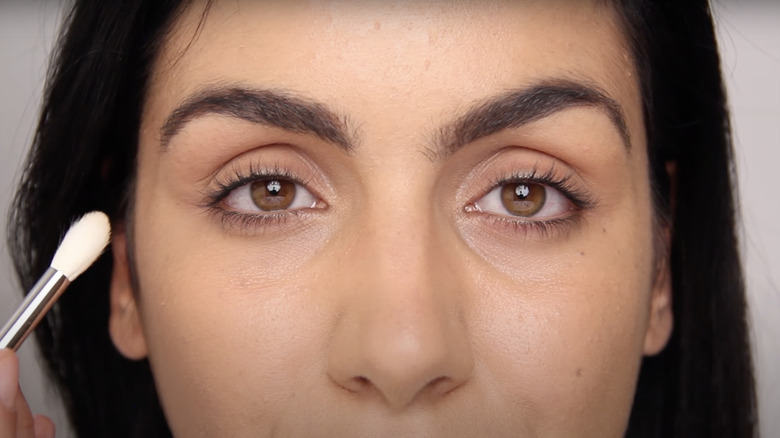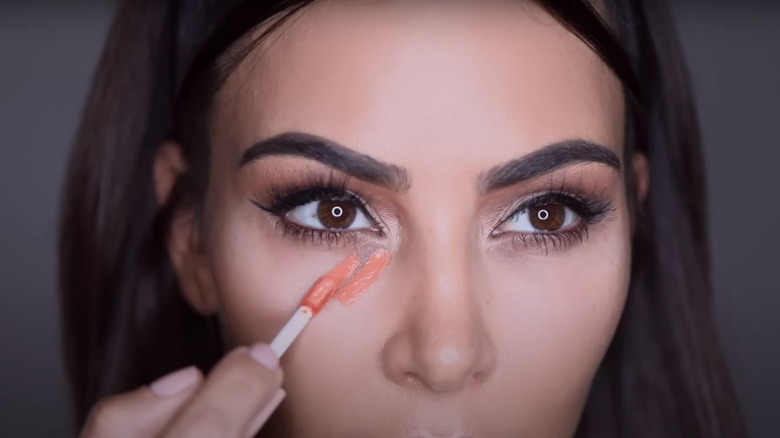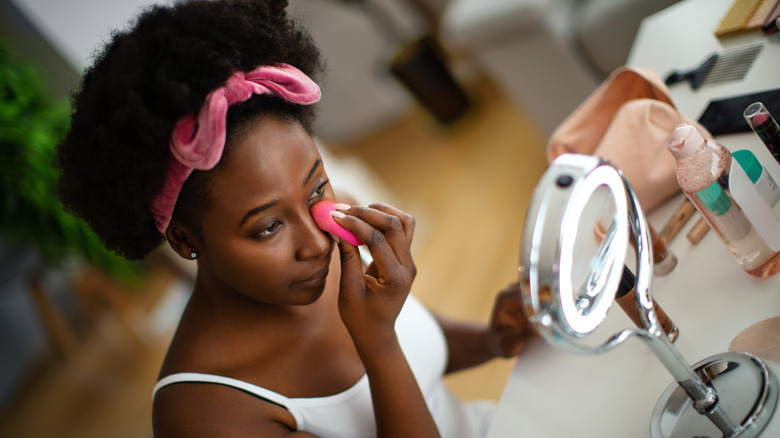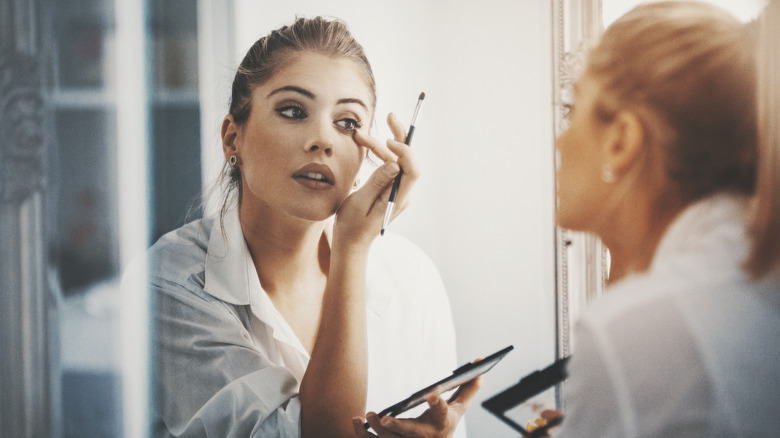Our Best Tips For Applying Concealer To Brighten Deep-Set Eyes
We may receive a commission on purchases made from links.
First of all, what does it mean to have a pair of deep-set, hollow, or sunken eyes? People with this facial feature have eyes that lie deeper within the eye socket. Deep-set eyes naturally accentuate the cheekbone and brow bone, but they also create a prominent crease and a dark shadow in the under-eye area due to the deeper position of the eyes. The shadowed area surrounding the eyes, therefore, can cause people to appear tired and pull focus away from the other facial features.
It's common for many individuals with deep-set eyes to struggle with hiding unwanted dark circles, but luckily, we have tips to brighten stubborn shadows. You will need all your standard makeup products, with the addition of a hydrating under-eye primer or moisturizer, a color corrector, and a setting powder. Get ready to tailor your concealer application for deep-set eyes with four of the best game-changing makeup tips.
Prime and correct
"The area around the eye is...thinner than the rest of the face, therefore dehydration is more evident, as with other ailments like puffiness, dark circles, lines, and wrinkles, as well as other signs of aging," dermatologic surgeon Dendy Engelman explains to Byrdie. So, regardless of whether the shadows under your eyes are a result of dark circles, hyperpigmentation, natural facial features, or a combination of all three factors, hydration can improve the look of your skin.
Working with a hydrated, well-prepped base will make all the difference when it's time to layer on your products, as it will prevent creasing and flaking from dryness. To prepare your under-eye area, apply a brightening eye cream or blurring primer and allow it to fully absorb before moving on to the next step.
After you prep your skin, apply a color corrector to the dark areas to help even out your skin tone and help you achieve a brighter complexion. To do this, you'll want to use an orange or peach color corrector to counteract the shadows. "Correctors are not one size fits all, so if you're a lighter skin tone looking to correct dark under-eye circles, you may need a peachy tone, whereas someone with deeper skin would need a rich orange," makeup artist Jaleesa Jaikaran tells Forbes.
Are you using the right concealer?
To brighten deep-set eyes, you'll want to choose the right concealer shade, as the concealer you use on the rest of your face may not be doing your dark circles any favors. "You actually do need a different under-eye concealer to brighten and add dimension to your face," San Diego-based makeup artist Taylor Haupt shares with Well + Good. "I prefer to go one to two shades lighter (at most) than the foundation color for the under-eye region."
The consistency of your concealer also makes a difference. "For under the eyes, you will want something more lightweight and hydrating than what you would use on your face," Haupt explains to Well + Good. A hydrating concealer is also crucial due to the thin and delicate skin around the eyes, which is prone to drying out and, therefore, requires more moisture (via Healthline). This especially applies if you already have a dry skin type.
Similarly, concealers with a watery or thin consistency will not provide you with much coverage — and those with deep-set eyes typically prefer fuller coverage under the eye — so look for a concealer that offers hydration but still feels buildable to effectively cover any hyperpigmentation under the eyes, such as a medium to full coverage concealer. For instance, the NARS Radiant Creamy Concealer has a hydrating formula with a light and creamy consistency, so it provides ample buildability that works wonders for dark circles.
The double bake trick
Deep-set eyes can have a more prominent under-eye crease. To keep your concealer in place and avoid creasing throughout the day, always set your product with a setting powder. You only need a small amount to help smooth any lines and blur the skin. "The more product that you use, the more likely it's going to crack as soon as you start smiling or talking," makeup artist Danessa Myricks tells Allure. And now, for the fun part: baking your makeup.
After applying a light layer of setting powder, you'll want to go back in with the same powder — but with a different technique called "baking," which involves letting it sit on the skin for a few minutes. The baking technique provides extra staying power and creates a smooth, airbrush effect.
In an interview with Allure, makeup artist Vincent Oquendo explains the best way to apply baking powder is to "[t]ake a damp beauty blender and use it to press in the powder underneath your eyes. Let it sit for a few minutes then wipe away the excess with a fluffy brush." Oquendo mentions receiving this tip from the iconic Winnie Harlow, so it's runway-approved.
The best concealing tools
Working with products around the eyes requires specific tools to avoid irritating and tugging the thin stretch of skin. Use tools that will blend the product into the skin without feeling too harsh after passing over the same area too many times.
"For larger areas (like dark under-eye circles or discoloration), clean fingers are fine," Los Angeles-based makeup artist Mandie Brice recommends to Insider. Not only will this prevent creasing and tugging, but it also helps absorption, as your natural body heat will encourage the product to blend more seamlessly into the skin.
However, a small fluffy brush also works well. "For under eyes, I like to use a synthetic and fluffy brush, because it ensures that there isn't too much product buildup, which can crease," Brice explains. As there are many fine lines and crevices within the hollow of the eyes, it's easy for the product to crease if there is too much product or if not properly blended. Adjusting your routine for deep-set eyes may take some trial and error, but once you nail down these tips, you can feel confident rocking any makeup look.




